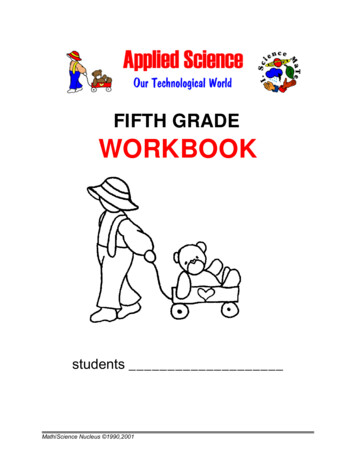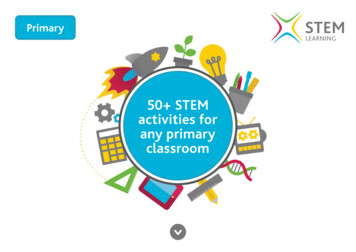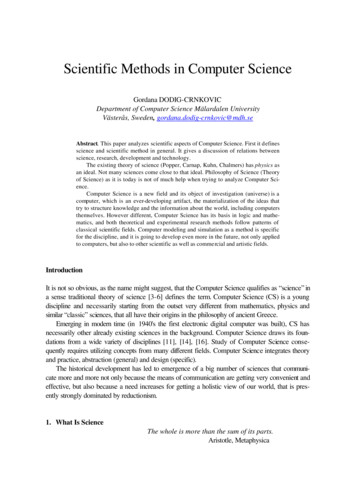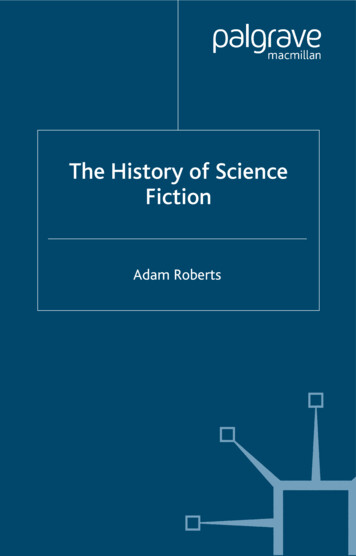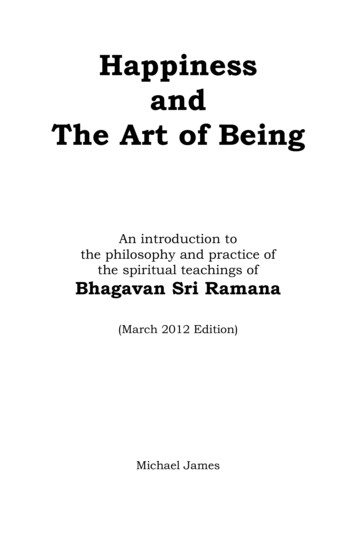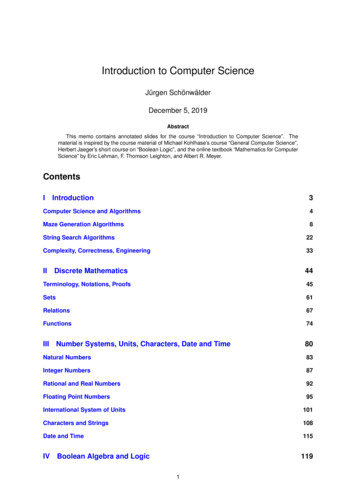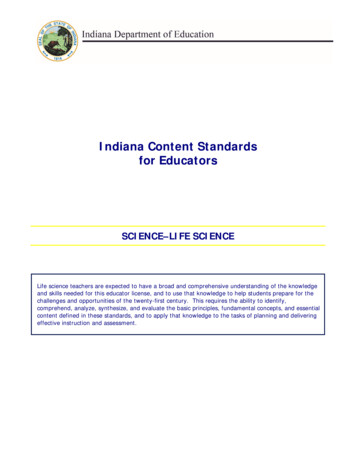
Transcription
Science ActivitiesChildren are fascinated by the world around them and are eager tolearn science related themes. The ideas that follow came from thewonderful women on my yahoo email lists childcareland2 andshelleylovettsecprintables.Some of our favorite science activities include:Planting a garden - Each year we plant a garden with different kindsof seeds . pumpkins . flowers etc. The children are amazed howmuch the plants grow in such a short time and that you can get a bigpumpkin from a small seed. The children are involved in every step ofthe gardening from planting to watering. If you do not have a gardenplot you can use you can always plant flowers in small containers.Magnets - We us magnets to try and pick up different objectsaround the room . I have the children go around and see what the
magnets will stick to and then we all sit down together and thechildren share what their magnets stuck to. I also lay differentobjects out an a table and create a chart that the children fill out.They record if their magnet picked up or stuck to the item on thetable.Flying Balloons - this activity is hysterical because the kids laugh somuch . You blow up a balloon with air and let it go so it flies aroundthe room and discuss what make the balloon fly.Measuring - we have measuring cups in our sand and water table sochildren can measure the sand and water.Apples - we cut apples in half and watch it turn brown and talk aboutwhy it turned brown.Feely Boxes - Fill boxes with different items and have childrenguess what is inside. Some great things to use are cotton balls .marbles . spaghetti noodles . cheerios etc.Freezing Water. Fill little small dixie cups with water about half way.Put in the freezer. Check every hour to see how the water is turninginto ice. Once it is frozen leave cups out and check to see how itmelts.Shelley Lovettchildcareland.comYou can order insect larvae from Insect Lore (www.insectlore.com)and watch them change and grow. My daycare has done ladybugs,butterflies and right now praying mantis. The children learn howthey change and even what each can and will eat. I have 10 prayingmantis inside right now and each day we look for aphids for them toeat.Colleen StephansenColleen's Child CareNAFCC Accredited Child Care in Riverbank, CA
Static electricity - Take an inflated balloon. Rub the balloonvigorously against a child's hair or sweater. Experiment withdifferent objects.where the balloon will stick? The curtains, theWall, the Refrigerator or ?Magnets: We do all sorts of things with our Magnet wands: want willit pick up and what will it not. I even have tons of letters, animals,etc with magnets that they play with too.a fun website: How to Introduce Science to a Toddler - eHow.comaddress: http://www.ehow.com/how 11444 introduce-sciencetoddler.htmlPlant a seed. Watch it grow. also, Plant two different pots of thesame thing - put one where it gets sun and water it, put the otherone in a dark place and dont' water it or at least not as much. Thencompare the plants.Watch the rain. Talk about the sounds that you hear during a rainstorm. What are the signs that a storm is coming. Talk about stormsafety. This will often help a younger child to not be so scared ofstorms.Scents: Gather different objects with different scents. Blindfoldthe children, then place the object close the child's nose, and askthem to smell it and try to identify what it is. ALso could use the oldfilm canisters - the black ones are best. put a scent in the canister,poke a hole or two in the lid so that child can smell it and try toguess what it is.Colleen (KS)One that I did with my children that was a big hit was rainbow toast.You need, food coloring, paintbrush, and bread. You mix the foodcoloring with water and paint on the bread. Make sure that thechildren do not get too much water on the paintbrush or the breadwill get soggy. Once bread is finished painting, toast in the toaster,the colors merge and the bread turns wonderful colors. The bestpart is the children get to eat there toast afterwards.
Thanks,Cheryl MartinCheryl's Childcare/Eden, NCIn my classroom we make crystal snowflakes using borax and nearboiling water. We start by making a snowflake from a pipe cleanerand then we tie that ot a cord tied to a pencil. We do that so it iseasily wound up if the pipecleaner snowflake is too long and touchesthe bottom of the can.Next we take a lagre coffee can and add almost boiling water 3/4 ofthe way to the top. then we add the borax laundy detergent andkeep mixing until the water is saturated. We than place ourpipecleaner snowflake in to the water. Take care to keep thepipecleaner off the bottom of the can and away from the sides ofthe can. If you do not crystals will form and the snowflake will beattached to the can. Carefully move the can to a safe locationa nadwait for the crystal snowflake to form. This can happen in a fewhours or overnight depending on the saturation of the water. We usethis to discuss how snowflakes are made of crystals.Carol WiltMagnets -- we play with magnets in the sand and get the iron fillingsout of it. The kids think it is great that there is stuff in sand thatmagnets can pull out. They then take the fillings and put them onpaper so they can make them stand up and dance.Squirrels, Birds & Insects -- We hunt for different insects and seethey defensive reactions such as watching millipedes and pill bugscurl up into balls. We watch the different birds and see what theydo in the trees. Sometimes, if we are still enough we are able tofeed the chickadees right from our hands. We feed the squirrelsnuts and seeds and watch them store them in their cheeks or in theground.Outside in the rain -- play in the puddles and rescue worms fromthem. Watch the worms wiggle and squirm and work their way back
into the ground. Look for their holes after it has stopped raining.Flowers -- watch the tulips or daylillies grow in the garden.Sometimes the squirrels come and dig up the bulbs. The kids give medaily reports on their progress.Make ice cream from scratch -- we have a non-electric ice creammaker which the kids love to use to make ice cream. They help to putthe ingredients together and help to stir it as it freezes.Baking in general chemistry in the kitchen -- the kids help to bakeour treats and learn about what baking soda & yeast does. The kidslove to watch bread rise or to punch out all the air from it to make itrise again. They also like to see the baking soda and vinegar combineto cause a balloon inflate on top of a pop bottle.Water play -- learn about dam making and how water moves. Theymake the water move really fast causing the boats and toys to goaround as well without them actually touching them.Tammy's Home DaycareSome of our favorite science activites, most are done as artq-tip paints- dip q-tip end into water color let dry,let children try to use the q-tip dry, ask what is happening discusswhat happens to dried out markers.spray the paper with water and let them use the q-tip on that ,discuss what is happeningMagnifying glasses and bincoulors- amazing what they find usingthem inside and outside.frozen paper- lightly spray a piece of paper with water, place oncookie sheet in freezer, leave till frozentake out use water colors, cryaons, markers ect. discuss whathappens as the paper begins to thaw.rain paintings- we use washable makers make a picture set out in therain(a light rain) watch what happens. One day one of my childrenwanted to rain paint (yes it was the most beautiful day in the world)both my assistant and I said sorry the sun is shinning, this child
looks up at us and says there is the water bottle.Senory bottles- dirt bottle, fill a bottle about 1/4 full with dirt, fillwith water, shake and see how the dirt seperatesCathyBubble Blaster Bags. We made these last week & the boys(I have anall boy group this year) loved them. I got this website from mychemistry class that has many experiments listedwww.exploratorium.edu/science explorer/bubblebomb.htmlChris in Wi.Sensory Bags: A clean way to explore coloring mixing. In a gallon sizefreezer bag place at least two squirts of primary colored paint.Reinforcethe top of the bag with packing tape. Encourage the children tosquish,smooth, squeeze, and smear the paint until it is mixed completely.Alsoworks well with hair gel. Shaving cream and food coloring also worksbutdoes not last long. Practice fine motor skills by having the children"draw" or write their name on the bag.Egg Carton Rainbows: During our Rainbow Theme, the childrenenjoyed usingeye droppers to mix colors in an egg carton. Fill each space with a bitofwater. Use food coloring to color the water in three differentspaces. Itworks better not to put the three cololrs right next to each other.Thechildren became very absorbed in this activity. Ice cube trays dowork alittle better with the younger children because they are sturdier.
Volcanoes: All time favorite with even the young children. Create a"volcano" by placing a cup or small bottle in a dampened sand areaand builda mountain around it. We've also created a volcano out of clay. Placebaking soda inside the "volcano". Pour vinegar dyed red and watchthevolcano erupt.Amber D.Play 'n' Learn Family Child CareOne of the things my kids love to do is make colored carnations.I buy white carnations and make a fresh cut in the stem. Then putthe flower in a glass filled with water with about 15-20 drops offood coloring. We try to decide which will color first. I usually usered, blue and green, and then do one carnation with a 3 way split inthe stem and stuck in all three colors. They have fun checking themevery hour or so to see if there is any progression and the next daythey love seeing the end results.LisaThe following ideas were sent in by Judy Santos who has collectedscience acitivity ideas from various sources:Science centerMy science center has a trifold which has a display of the 'things'weAre studying at the moment. Right now it is 5 senses. It'll change inOctober.I have a couple of feely cans, some smelly bottles, some spinningcolorTops and paddles, drop zone identifying activity, sandpaper hands tomatch up, a survey asking about favorite foods, books, journals fornoting thngs about our classroom pets (millipede, walking sticks, and
tadpoles), paper for drawing observations, directions for drawingthe different pets, hand lenses, a child's microscope, viewing boxes,trays of things to look at. all of these things are neatly (haha)stored in cubbies (except the animals and trifold and the 'activity'of the week--which on Friday goes into a cubbie for exploring later).Next month will be Earth, soil, rocks, water. I will have dirt, sand,clay, gravel, water, peat, bark mulch in topless 8 oz. size milkcartons.There will be popsicle sticks to stir and get samples with. Viewingtools,pictures of earth, soil (like gardening and farming pics), rocks,water (like lakes, rivers, oceans.), my rock colletion. a tub of peagravel to hide things in (maybe small earth balls or gold), and lots ofbooks on the subjects.November will be early tools. I'll have wedges, inclined planes,wheels,arrow heads, rope. and lots of pictures of our forefathersusing hand tools. and booksIn December I will have lots of toys to build and clocks and smallmotors to disassemble. Along with kid size tools. Our topic is partsof whole and push/pull.Scientist of the weekI have been working on a compilation of easy to do scienceexperiments for the Scientist of the Week.A CORK IN A BOWL- a glass- a cork- a bowl filled with water1- Float the cork on the water in the bowl.2- Place the glass upside down directly on the surfaceof the water, over the cork.3- Push the glass to the bottom of the bowl. The corkgoes down, or seems to "sink", but it remains on thesurface of the water.(The air in the glass pushes the water surface, wherethe cork floats, down to the bottom of the bowl. Aslong as the glass is full of air, water can't get in.)
I DON'T WANT TO GET MY FEET WET- a bowl filled with water- a glass- a piece of paper1- Crumple the paper and place it in the bottom of theempty glass.2- Put the glass upside down over the bowl, and pushit down into the water.3- Remove the glass and examine the paper; you willdiscover it is still dry.(There is air in the glass, and when the glass touchesthe surface of the water and you push down. the air isimprisoned. The water can't go into the glass becausethe air is taking up the space. To wet the paper, theair would have to be released; the air can be releasedif you tilt the glass.)I'M FLOATING. I'M SINKING.- 2 sheets of paper- a container of water1- Place 2 dry sheets of paper on the surface of thewater. They float.2- Completely wet one of the sheets of paper.3- You will notice that the dry sheet floats and thewet sheet of paper sinks.(When the paper is wet, the small air cells that thepaper is composed of are filled with water, thereforeit sinks. When the paper is dry, the small air cellsmake it float.)(This experiment can also be done with two sponges.The air cells in the sponge are visible because theyare very big. Make sure the wet sponge is completelysoaked to do this experiment.)YOU DON'T SEE ME, BUT I AM HERE- 2 balloons- string- weigh scales1- Inflate two balloons the same size and tie securelyso as no air can escape.2- Tie each balloon with an 18" string.3- Tie the string of each balloon to each end of the
scales so that they balance.4- Pop one of the balloons with a needle. The otherballoon will go down.(The two empty balloons were of equal weight, so whydoes the balloon filled with air go down when we popthe other? Air has weight: the popped balloon has nomore air, therefore it is lighter.)THE BALLOON THAT THOUGHT IT WAS VERY STRONG- a balloon- an empty jar1- Take the balloon and hold it so that it ispartially in the empty jar.2- As you blow into the balloon, the part that isinside the jar will expand until it touches the sidesof the jar.3- Continue blowing up the balloon and soon you willbe able to lift the jar with the help of the balloon.(The air pressure inside the balloon exerts force inall directions, pressing against the sides of the jarsor forcefullyl that it is impossible to free theballoon unless some air is released.)POTATO AND APPLE OR APPLE AND POTATO?- a raw potato, washed- an apple, washed- a blindfold1- Take a piece of peeled potato, and a piece ofpeeled apple.2- Blindfold one of your classmates, and ask him orher to pinche his or her nose really well.3- Have your classmate taste a piece of potato and apiece of apple.4- Can your classmate tell which is which?(Probably not. In order to taste food, the nose ismore important than the tonge. When you have a cold,you can't smell very much, which prevents you fromfully appreciating what you eat.)DON'T RUN OUT OF AIR- a balloon- a pop bottle1- Slip a balloon (NOT inflated) into the bottle,
stretching the top of the balloon over the bottleopening.2- Now try to inflate the balloon.3- Try as you may, you will not be able to!(The bottle is full of air taking up all the space,and can't escape because the balloon is closing thebottle's opening. It is therefore impossible toinflate the balloon.)I LOVE HEIGHTS- a small bottle- a piece of string (14" to 18" long)- a large jar- food colouring1- Tie the string around the neck of the small bottle.2- Fill the large jar with very cold water.3- Fill the small bottle with very hot water (theparent at home, and the teacher at school, will helpwith this part!) then add food colouring (add a LOT sothat the hot water is very dark).4- Holding the small bottle by the string, and keepingit upright, lower it slowly into the large jar untilit reaches the bottom.5- The coloured (hot) water will escape from the smallbottle by rising to the top, and will float over thecold water for a few seconds.(Hot water rises because it is more dilated than coldwater (the interval - or distance - between moleculesis greater. Consequently, hot water is lighter thancold water, and will float on the surface up until themoment the cold water and the hot water will mix andbecome lukewarm. Then the colouring will spread inthe liquid.)THE MAGIC BAG- a plastic bag- a sharp pencil- water- a container (to put under the experiment)1- Fill the plastic bag with water.2- Close it by tying a knot in it (or sealing it if itis a water-tight ziplock bag).3- Push the pencil through from one side to the other.
4- The water will not leak. (Be careful when youremove the pencil, though! Stay over the container preferably a large enough tub.)(When the pencil pierces the plastic, the moleculespress against the pencil to seal the opening made bythe pencil, so that no drop of water can escape.)Worm CompostingCheck out my units on worms. There are so great activities to dowiththe earthworms that I got from a course I took one ms.htmand six science lessons cience/sink or floatThere is a book titled "Who Sank The Boat?" by Patrick MacGee (Ithinkthat is the author's name) which would be perfct for a unit onfloating&sinkingWe made a predicition chart for various comman objects as towheterThey would sink or float and then we tested the results. I used afoamCore board with magnetic tape and graphics of objects I printed outfrom print artist. We also made boats out of clay and foil and trieddifferent shapes to test their bouancy. We discussed what theylearned. (the more suface level your boat has the better it floats.)We also used meat trays with a piggy graphic on them and predictedhow many pennies it would take to sink the piggy. You can use a bowltoo. Be prepared with pennies though because again, the bigger thesurface area, the more pennies it took to sink the trays.Just some quick thoughts on Science Day ideas.Purchase 4 small identical potted plants.
Label them:1. Water, Light, Air2. Water, Light, NO Air (seal with plastic bag, waterfrom bottom)3. Water, Air, NO light (Cover with a paper bag)4. NO Light, no air, no waterWatch what happens.then *************Put a white chrysanthemum in colored water. Weigh and measure students and compare to you grow mold on piece of bread make sprouts and eat! yeast rising.have kids mix water, flour, sugar andyeast and watch what happens.explore variables andcompare sizesBeans and Peas sprout very quickly. Here are some things to do withthem.1. Stuff a clear plastic (or glass)jar with cotton batting or quiltbatting. Soak beans (I used dried kidney beans from the grocerystore) overnight. Slide beans between the cotton and outside of thejar. Sprinke enough water over the cotton in the jar to keep it moistall the way to the outside. The beans will start to sprout in acouple of days. If you add one or two beans a day, starting now, bythe 15th you should have little bean plants at various stages ofdevelopment. They show up very nicely aganst the white background.2. Using the same technique put a few beans in the jar, let themgrowuntil they have a root and a pair of leaves (about a week) then turnthe jar over. The roots and sprout will change direction. (provingthat roots grow down and stems up)3. Soak some beans(the larger the better - try lima beans)for 24hours. The beans will swell a little and when they are split opencarefully you can see a very tiny plant inside complete with a root
and pair of leaves. Some inexpensive magnifying glasses help withthis project.4. I got this idea from GEMS I believe. Take a small ziplock bck andcut several thicknesses of paper towel to fit the bag. Tape(cleartape) a bean in the middle of the paper towel. Moisten the papertowel well and seal the bag. Make sure there is no air and the bag isflat. Hang the bag on a wall where it will get sun. As it growsrecord the amount of growth of root and stem using a fine marker.Thekind you use on transparencies. The GEM book had a premarked rulerthat could be taped to the bag but you could make your own.5. Start plants from the top of a carrot, eye of potato, top of aturnip etc. Put a little gravel in a dish, place vegetable pieces ontop of gravel and enough water to come to the top of cut root. Theywill sprout leaves and roots in a week or so. Put an onion in the topof a jar (you can support it with tothpicks. Put water in the jar sothat it touches the bottom of the onion. Explain that the carrot is aroot, the potato a tuber and the onion a bulb in order todemonstrateways that plants start other than seeds.6. To show how roots and stems transport water. Fill a jar withwatercolour with food colouring (blue is the best). Put a carrot, a celerystalk and a white flower (carnation for eg) in the jar. In 24 hoursyou will see the flower, any leaves on the celery and the top of thecarrot showing blue coloration. When you cut thin slices of thecarrot and the celery you will see the tiny holes in the root andstem where the blue water has travelled. I usually scrape the side ofthe celery stalk gently with a sharp knife until you can see the tubethat carries water all the way up.Great tie in to a physical science orchemistry unitScience Corner - Make Your Own PlasticExplore the word of Physical Science by making your own plastic!All science experiments should be closely supervised at all times.Raisin ElevatorsSupplies:
a. Clear, Carbonated Soda Waterb. Clear Glassc. 4-5 RaisinsPour clear carbonated soda water into a clear glass. Drop four orfiveraisins into the glass. After 40 - 60 seconds, the children willobserveraisins moving up and down in the glass. Teacher should help thechildrendraw the conclusion that the air bubbles caused the upwardmovement.Letchildren observe the glass later in the day when the carbonation hasceased.This will reinforce the role of the air bubbles in lifting the raisins.---submitted by Debbie.Soda FizzSupplies:a. tsp. of Bakins Sodab. Empty Soda Bottlec. tsp. of Vinigard. BalloonDemonstrate the following activity : place a teaspoon of baking sodainto anempty soda bottle and add a teaspoon of vinegar. The twosubstancescreate agas when they are mixed. This can be demonstrated by placing aballoonoverthe top of the soda bottle. It will expand from the gas. More ofeachsubstance will expand the balloon even more. Allow each child to mixthe twosubstances. Provide a paper plate, small cup of vinegar and a smallcupofbaking soda. Each child can use a spoon to put the baking soda on theplateand an eyedropper to add the vinegar. The mixture will fizz.
---submitted by Debbie.Wave MakerSupplies:a. Clear, Plastic Bottle (atleast 10 inches high)b. Denatured Alcoholc. Blue Food Colord. Vegetable OilFill the bottle three-fourths full using denatured alcohol. Add bluefoodcoloring (make it a deep blue) Fill the bottle with cooking oil,leaving asmall space at the top. Glue the top on for safety. The substanceswillnotmix and the water will move like a wave over the oil when moved upanddown.---submitted by Debbie.Sink and Float ExperimentsSupplies:a. Large Bowl (or whatever) filled with Waterb. Various ObjectsHave the children predict (teacher can graph) whether they think anobjectwill sink or float.---submitted by Debbie.Disolving ExperimentsSupplies:a. Clear Cups (or whatever) filled with waterb. Various objectsHave the children experiment with different materials to see iftheywilldissolve in water.---submitted by Debbie.
Ice Cube ExperimentSupplies:a. Small Glassesb. Vegetable Oilc. Ice CubeFill glass with oil. Place an ice cube in the glass - the ice floatsnearthe top. Observe your experiment for a while. Notice that as the icemelts,water droplets sink to the bottom. Why? As water freezes, itexpandsandtakes up more room. This makes it less dense and therefore it floatsontheoil. Once it has melted, the water is heaver that the oil and it fallstothe bottom.---submitted by Mary in MN.ExplosionsSupplies:a. Alka Selzer Tablets (generic work fine and are cheaper)b. Empty Film Canisters (clear ones work best)c. Hot WaterDraw a line around bottom of film canister about 1 cm from bottom(alittleless than 1/2" for the metrically impaired). Fill up to that line withwarmwater. I use tap water that is hot enough to be steaming and fill acoffeemug with cover on it so the kids can pour the water themselves.Place1/4 ofan alka selzer tablet in the canister and immediately secure cover,turnupside down and place on sidewalk/driveway or similar surface inopenarea(BTW, this is an *outdoor* activity!) Stand back and wait for
"explosion" asthe gases build up and the film canister bottom goes FLYING in theairabout20 feet. Be sure to buy lots of Alka Selzer because the kids want todothisone again and again!!!!---submitted by Mary in MN.Crystal GardenSupplies:Place broken pieces of brick or terra cotta clay in a glass bowl orjar.Pour the following solution over this:a. 1 tsp waterb. 1 tsp ammoniac. 4 tsp bluingd. 1 tsp Mercurochromee. 4 tsp saltAdd more of this solution each day until the crystal garden hasgrownto thedesired size. (Adult supervision required.)---submitted by Melissa in TX.Air BlowersSupplies:a. Party Blowerb. Plastic BaggieTake a party blower (the ones that unfurl as you blow into them) andaplastic baggie. Blow air into the baggie, capturing it as it becomesfull.Attach the blower (mouth-end into the end of the baggie) andsecure sonoair leaks out. By squeezing the baggie, you can blow up the partyhorn.Thechild can then control the movement of air, the air takes up space,
etc.Lots of principles here!Rainbows -Version1Supplies:a. Small Mirrorb. Small Dish of WaterPlace a small mirror in a small dish of water. Place in direct sunlightandwatch the rainbow form on an adjacent wall. Try moving the mirror inand outof the water and see the differences. Shows light diffraction, etc.---submitted by Lela.Rainbows -version2Supplies:a. Shallow Dishb. Milkc. Food Coloringd. Liquid Dish SoapPlace milk in a shallow dish and add drops of several different foodcolorsaround the dish. Add a drop of liquid dish soap and watch watch whathappens! Interesting chemical reaction! ---submitted by Lela.Rainbows -version3Supplies:a. Jar of Cold Waterb. Food ColoringPlace a clear jar of cold water on the table so it can be undisturbedbutobserved. Add drops of food coloring and watch the "rainbows"appear.Tryvarying the water temp, consistency (add oils, etc), stirring and soon.Shows color mixing, properties of matter, etc.---submitted by Lela.
Egg in a BottleSupplies:a. Glass Apple Cider or Apple Juice Jugb. Newspapersc. Hard Boiled EggsYou need a glass empty apple cider or apple juice jug. Put tornnewspapersin the jug and light. As soon as the fire gets going place a hardboiled eggon top. Soon it will get sucked into the jar with a pop. My kids lovethis.---submitted by Teresa from Texas.Race to the TopSupplies:a. Pole bean or pea seeds, one per childb. Potting soilc. Dowel rods or sticks, one per childd. Potting cups, one per childe. String lengths, one per childAnchor strings to a hanging dowel rod or hang directly from theceilingby apush pin. Let each child plant her own bean/pea in a cup. Tie the endof astring to a stick and insert the stick in a child's cup so the bean canclimb up the stick and then on the string. Repeat with all the cups.Waterthe beans periodically and watch them climb the string.---submitted by Cheryl. : All science experiments should be closelysupervised at all times.Raisin ElevatorsSupplies:a. Clear, Carbonated Soda Waterb. Clear Glassc. 4-5 RaisinsPour clear carbonated soda water into a clear glass. Drop four orfive
raisins into the glass. After 40 - 60 seconds, the children willobserveraisins moving up and down in the glass. Teacher should help thechildrendraw the conclusion that the air bubbles caused the upwardmovement.Letchildren observe the glass later in the day when the carbonation hasceased.This will reinforce the role of the air bubbles in lifting the raisins.---submitted by Debbie.Soda FizzSupplies:a. tsp. of Bakins Sodab. Empty Soda Bottlec. tsp. of Vinigard. BalloonDemonstrate the following activity : place a teaspoon of baking sodainto anempty soda bottle and add a teaspoon of vinegar. The twosubstancescreate agas when they are mixed. This can be demonstrated by placing aballoonoverthe top of the soda bottle. It will expand from the gas. More ofeachsubstance will expand the balloon even more. Allow each child to mixthe twosubstances. Provide a paper plate, small cup of vinegar and a smallcupofbaking soda. Each child can use a spoon to put the baking soda on theplateand an eyedropper to add the vinegar. The mixture will fizz.---submitted by Debbie.Wave MakerSupplies:a. Clear, Plastic Bottle (atleast 10 inches high)
b. Denatured Alcoholc. Blue Food Colord. Vegetable OilFill the bottle three-fourths full using denatured alcohol. Add bluefoodcoloring (make it a deep blue) Fill the bottle with cooking oil,leaving asmall space at the top. Glue the top on for safety. The substanceswillnotmix and the water will move like a wave over the oil when moved upanddown.---submitted by Debbie.Sink and Float ExperimentsSupplies:a. Large Bowl (or whatever) filled with Waterb. Various ObjectsHave the children predict (teacher can graph) whether they think anobject will sink or float.Disolving ExperimentsSupplies:a. Clear Cups (or whatever) filled with waterb. Various objectsHave the children experiment with different materials to see iftheywill dissolve in water.Ice Cube ExperimentSupplies:a. Small Glassesb. Vegetable Oilc. Ice CubeFill glass with oil. Place an ice cube in the glass - th
science acitivity ideas from various sources: Science center My science center has a trifold which has a display of the 'things' we Are studying at the moment. Right now it is 5 senses. It'll change in October. I have a couple of feely cans, some smelly bottles, some spinning color Tops a


